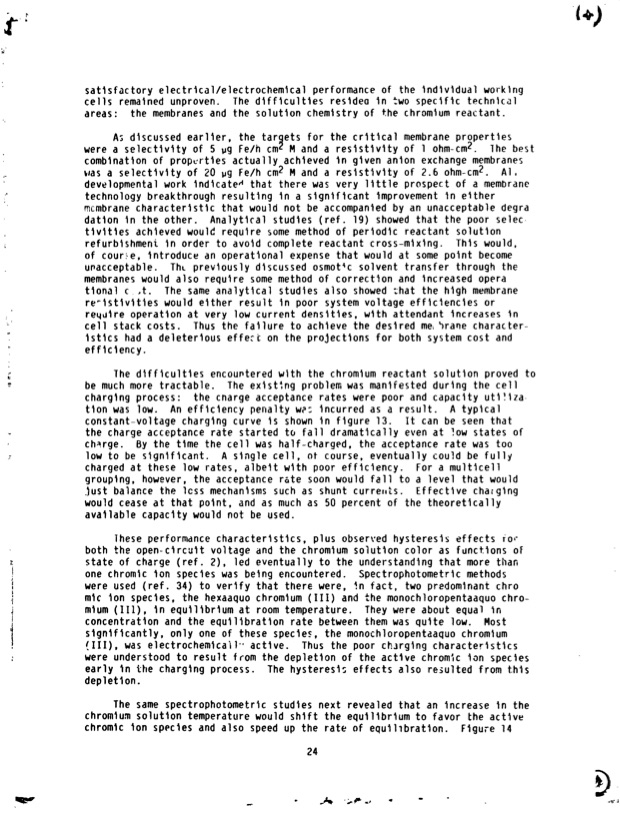
PDF Publication Title:
Text from PDF Page: 027
satisfactory electrical/electrochemlcal performance of the individual working cells remained unproven. The difficulties resldea i n two specific technical areas: the membranes and the solution chemistry of the chromium reactant. A; discussed earlier, the tar ets for the critical membrane properties 9 t i v i t i e s achieved would require some method of periodic reactant solution refurbishment i n order to avoid complete reactant cross-mixing. This would, of cour?e, introduce an operational expense that would at some point become unacceptable. T ~ Lpreviously discussed osmotic solvent transfer through the membranes would also requlre some method of correction and Increased opera tional c .t. The same analytical studies also showed :hat the high membrane recistivities would either result In poor system voltage efficiencies or revdire operation a t very low current densities, with attendant increases i n cell stack costs. Thus the failure to achieve the desired me, jrane character- istics had a deleterious effect on the projections for both system cost and efficiency. The dlfficulties encou~tersdwlth the chromium reactant solution proved to be much more tractable. The exlsttng problem was manlfested during the cell charging process: the cnarge acceptance rates were poor and capacity utiliza- tion was low. An efficiency penalty w?: incurred as a result. A typical constant-voltage charging curve i s shown i n figure 13. It can be seen that the charge acceptance rate started to fall dramatically even at ?owstates of charge. By the time the c e l l was half-charged, the acceptance rate was too low to be significant. A single cell, ot course, eventually could be fully charged at these low rates, albeit wlth poor efflclency. For a multicell grouping, however, the acceptance rcte soon would fall to a level that would just balance the lcss mechanlsms such as shunt currer~ts. Effective chaiglng would cease at that point, and as much as 50 percent of the theoretically available capacity would not be used. These performdnce characteristics, plus observed hysteresis effects rot- both the open-circuit voltage and the chromium solution color as functions of state of charge (ref. 2), led eventually to the understanding that more than one chromic ion species was being encountered. Spectrophotometric methods were used (ref. 34) to verify that there were, !n fact, two predominant chro mic ion species, the hexaaquo chromium (111) and the monochloropentaaquo chro- mium ( I I I ) , i n equllibrtum a t room temperature. They were about equal I n concentration and the equilibration rate between them was quite low. Host significantly, only one of these species, the monochloropentaaquo chromium (111). was electrochemicail+. active. Thus the poor ch~rgtngcharacteristics were understood to result from the depletion of the active chromtc Ion species early i n the charglng process. The hysteresjz effects also resulted from t.his depletion. The same spectrophotometric studies next revealed that an increase In the chromium solution temperature would shift the equilibrium to favor the active chromic ion species and also speed up the rate of equilibration. Figure 14 were a selectivity of 5 vg Fe/h cm M and a resistivity of 1 ohm-cm2. 1he best combination of properties actually achieved I n given anion exchange membranes was a selectivity of 20 vg Fe/h cm2 M and a resistivity of 2.6 ohm-cm2. Al, developmental work indicate* that there was very l i t t l e prospect of a membrane technology breakthrough resulting i n a significant improvement i n either rncrnbrane characteristic that would not be accompanied by an unacceptable degra dation i n the other. Analytical studies (ref. 19) showed that the poor selec-PDF Image | NASA Redox Storage System Development Project

PDF Search Title:
NASA Redox Storage System Development ProjectOriginal File Name Searched:
19850004157.pdfDIY PDF Search: Google It | Yahoo | Bing
CO2 Organic Rankine Cycle Experimenter Platform The supercritical CO2 phase change system is both a heat pump and organic rankine cycle which can be used for those purposes and as a supercritical extractor for advanced subcritical and supercritical extraction technology. Uses include producing nanoparticles, precious metal CO2 extraction, lithium battery recycling, and other applications... More Info
Heat Pumps CO2 ORC Heat Pump System Platform More Info
| CONTACT TEL: 608-238-6001 Email: greg@infinityturbine.com | RSS | AMP |